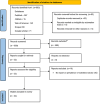Prevalence and patterns of substance use in West Africa: A systematic review and meta-analysis
- PMID: 39739732
- PMCID: PMC11687703
- DOI: 10.1371/journal.pgph.0004019
Prevalence and patterns of substance use in West Africa: A systematic review and meta-analysis
Abstract
Introduction: Substance use is a growing public health concern in West Africa, contributing to significant morbidity, mortality, and socioeconomic challenges. Despite the increasing prevalence, comprehensive data on the patterns and factors influencing substance use in the region remain limited. This systematic review and meta-analysis aim to synthesize existing research on the prevalence and patterns of substance use in West Africa, providing critical insights for developing targeted interventions and policies.
Methodology: This study followed the Preferred Reporting Items for Systematic Reviews and Meta-Analyses [PRISMA] guidelines. A systematic search was performed across four major databases [PubMed, Web of Science, CINAHL, and Scopus] from January 2000 to June 2024. A total of 22 studies involving 43,145 participants met the inclusion criteria. Multiple reviewers performed data extraction and quality assessment independently, and a random-effects meta-analysis was used to estimate the pooled prevalence of various substances. Sensitivity analysis was conducted using a leave-one-out approach to evaluate the influence of individual studies on the overall prevalence.
Results: The meta-analysis revealed the pooled prevalence rates of alcohol [44%], cannabis [6%], tramadol [30%], codeine [11%], and kolanut [39%]. The analysis identified high heterogeneity across studies [I2 = 98-99%], reflecting diverse substance use patterns and influencing factors, including peer influence, availability of substances, socioeconomic conditions, and demographic characteristics. Sensitivity analysis indicated that no single study significantly impacted the overall prevalence estimates, confirming the robustness of the findings.
Conclusion: Substance use in West Africa is widespread and influenced by complex factors. The high prevalence of alcohol and tramadol use highlights the urgent need for targeted public health interventions, including stricter regulatory frameworks, community-based prevention programs, and comprehensive public education campaigns. This study provides a critical foundation for developing effective strategies to mitigate the escalating substance use crisis in the region.
Copyright: © 2024 Emmanuel et al. This is an open access article distributed under the terms of the Creative Commons Attribution License, which permits unrestricted use, distribution, and reproduction in any medium, provided the original author and source are credited.
Conflict of interest statement
The authors have declared that no competing interests exist.
Figures












Similar articles
-
Recovery schools for improving behavioral and academic outcomes among students in recovery from substance use disorders: a systematic review.Campbell Syst Rev. 2018 Oct 4;14(1):1-86. doi: 10.4073/csr.2018.9. eCollection 2018. Campbell Syst Rev. 2018. PMID: 37131375 Free PMC article.
-
The future of Cochrane Neonatal.Early Hum Dev. 2020 Nov;150:105191. doi: 10.1016/j.earlhumdev.2020.105191. Epub 2020 Sep 12. Early Hum Dev. 2020. PMID: 33036834
-
Beyond the black stump: rapid reviews of health research issues affecting regional, rural and remote Australia.Med J Aust. 2020 Dec;213 Suppl 11:S3-S32.e1. doi: 10.5694/mja2.50881. Med J Aust. 2020. PMID: 33314144
-
Magnitude and risk factors of khat, alcohol and cigarettes use among pregnant women in Africa: a systematic review and meta-analysis.BMC Pregnancy Childbirth. 2024 Nov 27;24(1):795. doi: 10.1186/s12884-024-06999-7. BMC Pregnancy Childbirth. 2024. PMID: 39604865 Free PMC article.
-
Current Epidemiological Status of Chikungunya Virus Infection in East Africa: A Systematic Review and Meta-Analysis.J Trop Med. 2024 Oct 25;2024:7357911. doi: 10.1155/2024/7357911. eCollection 2024. J Trop Med. 2024. PMID: 39492843 Free PMC article. Review.
References
-
- GBD 2017 Disease and Injury Incidence and Prevalence Collaborators. Global, regional, and national incidence, prevalence, and years lived with disability for 354 diseases and injuries for 195 countries and territories, 1990–2017: a systematic analysis for the Global Burden of Disease Study 2017. Lancet Lond Engl. 2018. Nov 10;392(10159):1789–858. doi: 10.1016/S0140-6736(18)32279-7 - DOI - PMC - PubMed
-
- United Nations: Office on Drugs and Crime (Internet). (cited 2024 Aug 11). World Drug Report 2021. Available from: //www.unodc.org/unodc/en/data-and-analysis/wdr2021.html
LinkOut - more resources
Full Text Sources
Miscellaneous
